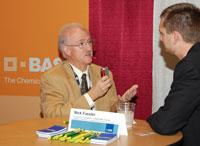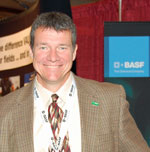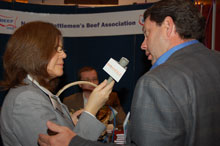BASF Corporation has just introduced a new online, interactive educational module – planthealtheducation.com. The new learning program is customized by region and provides growers with education on disease control, Plant Health benefits and resulting yield advantages of F500®, the active ingredient found in Headline® fungicide, Headline AMP™ fungicide and TwinLine® fungicide.
“This educational session gives growers an in-depth look at F500 and will help growers evaluate the science behind Plant Health and the disease control of these products,” said Nick Fassler, BASF Technical Market Manager. “It lays out key information about fungicides, including disease control, harvest efficiency, and other Plant Health benefits of fungicides.”
 Headline was Nick’s topic at NAFB Trade Talk this year. He is pictured here on the right being interviewed by Gary Jackson of ABN Radio. Nick says that Headline is labeled on over 90 crops, from sugar beets to legumes, soybeans, corn, wheat, to citrus and sugar cane. “A very widely used product and that just proves how effective the active ingredient is and what kind of performance we’re seeing from it,” Nick said. Headline AMP was just launched this year and Nick says it was used on about 500,000 acres this season. “Headline AMP is everything Headline is, plus metconazole, a new triazole for corn, and that’s bringing added disease control.”
Headline was Nick’s topic at NAFB Trade Talk this year. He is pictured here on the right being interviewed by Gary Jackson of ABN Radio. Nick says that Headline is labeled on over 90 crops, from sugar beets to legumes, soybeans, corn, wheat, to citrus and sugar cane. “A very widely used product and that just proves how effective the active ingredient is and what kind of performance we’re seeing from it,” Nick said. Headline AMP was just launched this year and Nick says it was used on about 500,000 acres this season. “Headline AMP is everything Headline is, plus metconazole, a new triazole for corn, and that’s bringing added disease control.”
Listen to my interview with Nick where he also talks about special offers for growers. Nick Fassler Interview
 And while we are on the BASF beat, I also talked with Dr. Dan “the Kixor man” Westberg about the amazingly successful launch of Kixor herbicide products this past year. “With over 10 million acres treated this year with our family of products with Kixor herbicide technology, it’s the most successful herbicide launch in the last 20 years – a real testament to the fact that growers were looking for better broadleaf weed control,” Dr. Dan said. After a year on the market, Dan says they have updated the Kixor product line so that one can be used on both corn and soybeans and changing the name from Integrity to Verdict.
And while we are on the BASF beat, I also talked with Dr. Dan “the Kixor man” Westberg about the amazingly successful launch of Kixor herbicide products this past year. “With over 10 million acres treated this year with our family of products with Kixor herbicide technology, it’s the most successful herbicide launch in the last 20 years – a real testament to the fact that growers were looking for better broadleaf weed control,” Dr. Dan said. After a year on the market, Dan says they have updated the Kixor product line so that one can be used on both corn and soybeans and changing the name from Integrity to Verdict.
Listen to Dr. Dan discuss the Kixor launch and what’s coming down the road from BASF. Dan Westberg Interview
 In addition to uniting with other agriculture groups urging Congress to fix the “death tax,” American Soybean Association (ASA) farmer-leaders are participating in a biodiesel fly-in to discuss renewing the biodiesel tax incentive that expired at the end of last year.
In addition to uniting with other agriculture groups urging Congress to fix the “death tax,” American Soybean Association (ASA) farmer-leaders are participating in a biodiesel fly-in to discuss renewing the biodiesel tax incentive that expired at the end of last year. 
 Ten diverse agricultural organizations are conducting a press conference right now in Washington DC to urge Congress to act on estate tax reform during the lame-duck session.
Ten diverse agricultural organizations are conducting a press conference right now in Washington DC to urge Congress to act on estate tax reform during the lame-duck session.  Headline was Nick’s topic at NAFB Trade Talk this year. He is pictured here on the right being interviewed by Gary Jackson of ABN Radio. Nick says that Headline is labeled on over 90 crops, from sugar beets to legumes, soybeans, corn, wheat, to citrus and sugar cane. “A very widely used product and that just proves how effective the active ingredient is and what kind of performance we’re seeing from it,” Nick said. Headline AMP was just launched this year and Nick says it was used on about 500,000 acres this season. “Headline AMP is everything Headline is, plus metconazole, a new triazole for corn, and that’s bringing added disease control.”
Headline was Nick’s topic at NAFB Trade Talk this year. He is pictured here on the right being interviewed by Gary Jackson of ABN Radio. Nick says that Headline is labeled on over 90 crops, from sugar beets to legumes, soybeans, corn, wheat, to citrus and sugar cane. “A very widely used product and that just proves how effective the active ingredient is and what kind of performance we’re seeing from it,” Nick said. Headline AMP was just launched this year and Nick says it was used on about 500,000 acres this season. “Headline AMP is everything Headline is, plus metconazole, a new triazole for corn, and that’s bringing added disease control.” And while we are on the BASF beat, I also talked with Dr. Dan “the Kixor man” Westberg about the amazingly successful launch of Kixor herbicide products this past year. “With over 10 million acres treated this year with our family of products with Kixor herbicide technology, it’s the most successful herbicide launch in the last 20 years – a real testament to the fact that growers were looking for better broadleaf weed control,” Dr. Dan said. After a year on the market, Dan says they have updated the
And while we are on the BASF beat, I also talked with Dr. Dan “the Kixor man” Westberg about the amazingly successful launch of Kixor herbicide products this past year. “With over 10 million acres treated this year with our family of products with Kixor herbicide technology, it’s the most successful herbicide launch in the last 20 years – a real testament to the fact that growers were looking for better broadleaf weed control,” Dr. Dan said. After a year on the market, Dan says they have updated the 
 During the recent NAFB convention Trade Talk session this was one of the items that came up in
During the recent NAFB convention Trade Talk session this was one of the items that came up in 



